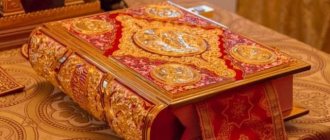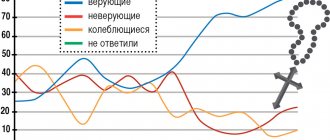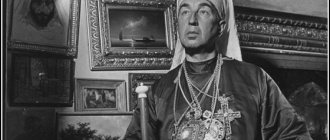This term has other meanings, see Patriarch (meanings).
Patriarch
(Greek πατριάρχης from ancient Greek πατήρ “father” + ἀρχή “dominance, power; beginning”) - the title of the bishop-primate of the autocephalous Orthodox Church in a number of Local Churches.
Historically, before the Great Schism, it was assigned to the six bishops of the Universal Church (Rome, Constantinople, Alexandria, Antioch, Jerusalem and Bulgaria), who had the rights of supreme church-governmental jurisdiction in the churches they led. In any autocephalous church, the patriarch is elected by the Local Council or the Council of Bishops.
Story
Patriarch Abraham
The Old Testament tells about ten antediluvian patriarchs - these are Adam, Seth, Enosh, Cainan, Maleleel, Jared, Enoch, Methuselah, Lamech and Noah (Gen. 5: 1-32). After the flood and before the giving of the law to Moses, the patriarchs were Abraham, Isaac and Jacob. The sons of Jacob are also called the twelve patriarchs. In all these cases, the meaning of the word patriarch is not religious, but generic, that is, it means ancestors.
During the period between the Testaments and the New Testament, the title of patriarch was borne by the chairmen of the Sanhedrin.
In the early Christian church, the head of the church was a bishop. The title of Patriarch has been spreading since the 5th century - it is received by bishops who dominate the metropolitans. The term appears in the documents of the IV Ecumenical Council (451).
In the 6th century, the doctrine of the Pentarchy arose in Byzantium: there can only be five patriarchs in the Church. Discussions about the Pentarchy also penetrated into the Russian Helmsman's Book (Chapter 40) from the Synopsis
Stephen of Ephesus through
the Helmsman of
St. Savva.
After the Schism of 1054, the title of Patriarch was assigned primarily to the Primates of the Eastern Church.
The full title of the Bishop of Rome until 2006 included, among others, the title "Patriarch of the West".
In Orthodoxy, the dignity and title of Patriarch
a different, higher degree of priesthood than the general episcopal one does not matter, although in Moscow in the 17th century such a view was very widespread. Simply, the patriarch is the most important bishop, the first hierarch in the autocephalous church.
In the East
In the Byzantine Empire, the Church was headed by four Patriarchs: the bishops of Constantinople (see Patriarchs of Constantinople), Alexandria, Antioch and Jerusalem.
With the emergence of independent Slavic states (Bulgaria, Serbia) and the acquisition of autocephaly by their Churches, patriarchs also became their heads.
In Russia
Main article: Patriarch of Moscow and All Russia
In Russia, the first patriarch was installed by the Moscow Council under the chairmanship of Patriarch Jeremiah II of Constantinople in 1589.
The first patriarch of the Russian Church was Patriarch Job (years of patriarchate 1589-1607). During his enthronement, he was again ordained bishop. In 1606, Patriarch Hermogenes was elected. Tsar Vasily Ivanovich Shuisky chose him from the candidates proposed by the Council of Bishops.
The patriarchal power in Russia reached its greatest power under Patriarch Filaret, the father of the new Tsar Mikhail Fedorovich. During Nikon's patriarchate, a clash occurred between him and Tsar Alexei Mikhailovich, the cause of which was Nikon's claims to complete judicial and property immunity of the Russian Church. As a result of this clash, Nikon was deposed by the Council of Bishops, but his reforms were not canceled.
Patriarch Joasaph I, who assumed the Moscow patriarchal see in 1634, was chosen as his successor by Patriarch Filaret himself with the consent of the tsar, but the established form of Patriarchal election was observed over him as well. The next patriarch, Joseph, was chosen by lot.
Patriarch Bartholomew, Svetlana Medvedeva and Patriarch Kirill
The gradual actual subordination of the patriarchs to secular power was completed under Peter I, who, after the death of Patriarch Adrian in 1700, appointed not a patriarch, but a guardian of the Patriarchal Throne, and in 1721 established the Holy Governing Synod.
The Patriarchate was completely restored by the Local Council of the Russian Orthodox Church. In 1917, Tikhon was elected patriarch. After the death of Patriarch Tikhon in 1925, no new patriarch was elected.
In 1943, the Local Council was convened again. 19 hierarchs took part in the Council. There was only one candidate in the voting - Metropolitan Sergius (Stragorodsky), who was elected by open voting. Then the patriarchs were Alexy I, Pimen, Alexy II. In 2009, Kirill was elected the sixteenth Patriarch of Moscow and All Rus'.
Regulations on the Patriarch in the Charter of the Russian Orthodox Church
The main document on the patriarchate in the Russian Orthodox Church is the Regulations on the Patriarch in the Charter of the Russian Orthodox Church[1]. According to this document, the Primate of the Russian Orthodox Church bears the title “His Holiness Patriarch of Moscow and All Rus'”, has primacy of honor among the bishops of the Russian Orthodox Church and is accountable to the Local and Bishops’ Councils. The name of the Patriarch of Moscow and All Rus' is exalted during divine services in all churches of the Russian Orthodox Church according to the formula: “On the Great Lord and Our Father (name), His Holiness Patriarch of Moscow and All Rus'.”
The meaning of the word patriarchy
Examples of the use of the word patriarchy in literature.
After that memorable reception, listening to the endless reproaches of Cantacuzinus in the secrets of the patriarchy, Alexy could hardly restrain his desire to defend the king in a loud dispute.
This precaution is apparently connected with the fact that Brankovich here, in particular, considers various heresies, not only Christian, but also Jewish, and Mohammedan, and our patriarch from the Pec Patriarchate, who every August on the day of the Dormition of St. Anne lists all the anathemas , of course, one of them would have been assigned to Abram, had he known what he was up to.
Orthodox Vagan was seriously angered by a certain young journalist who was insidiously infiltrating the ranks of believers and then pouring buckets of dirt, diluted with half-truths, on the Moscow Patriarchate.
It was quite clear that they sent him for a reason, but purely in spite of and contrary to Moscow’s desire to install his successor to Peter, Theodore, who was rejected by the Constantinople Patriarchate.
But then for some reason everything went wrong and now Archbishop Hermogenes stopped visiting the Patriarchate.
Lycurgus, Bishop of Syria, visiting Athos in the year 73, also stopped by the rich Bulgarian monastery of Zograf, whose monks did not want to break the connection with the Patriarchate, but behaved very carefully between their Bulgarian committees and the Constantinople hierarchy.
With great difficulty, and only with the help of Gervasius, it was possible to persuade Pimen to simply cross the Bosphorus: the power of the Greek Basileus did not extend to the Turkish coast and the monasteries there were not directly subordinate to the patriarchy.
The departments of the Moscow Patriarchate, where nomenklatura monks loitered, for whom monastic vows were only a career moment in their biography, a step to episcopacy, enjoyed a particularly bad reputation.
Manuel needed an army, the Patriarchate needed silver to feed the numerous cassock-wearing brethren, which to Ivan, in the face of the Turkish thunderstorm, seemed absurd.
When the dogma of the filioque was first proposed, the Patriarchate of Constantine considered it to be a change in Christian doctrine to please Rome.
Georgy Edelstein, - The Moscow Patriarchate actively collaborated with the communists and their followers all over the world, preached from church pulpits, at assemblies, conferences, on the radio and in the press exactly what the Solovetsky confessors recognized as the most shameful lie and destructive temptation.
Back in the summer, he ordered all the information about the patriarch to be collected and sent a couple of spies to Gran Betika, where the patriarchate of the Nestorian Church is located.
Cyprian had his spies in Constantinople in the secrets of the Patriarchate and now, with an internal groan and gnashing of teeth, he read the message of the new Patriarch Macarius, rewritten and sent to him in Moscow.
How amazing is the combination of talent, knowledge, high bookmaking and icon painting among today's Greeks with arrogance, corruption and mouse fuss in the secrets of the patriarchy!
Indeed, the note that Juren Berzin Landsbergis left the territory of the sacristy at 0 hours 53 minutes took place in the security system of the Patriarchate.
Source: Maxim Moshkov library
In modern Orthodoxy
Generally recognized
The title is given to the heads of churches:
- of Constantinople - Archbishop of Constantinople - New Rome and Ecumenical Patriarch,
- of Alexandria - Pope and Patriarch of the Great City of Alexandria, Libya, Pentapolis, Ethiopia, all Egypt and all Africa, Father of Fathers, Shepherd of Shepherds, Bishop of Bishops, Thirteenth Apostle and Judge of the Universe,
- Antioch - Patriarch of the Great City of God of Antioch, Syria, Arabia, Cilicia, Iberia, Mesopotamia and the entire East,
- Jerusalem - Patriarch of the Holy City of Jerusalem and all Palestine, Syria, Arabia, all Transjordan, Cana of Galilee and Holy Zion,
- Russian - Patriarch of Moscow and All Rus',
- Georgian - Catholicos-Patriarch of All Georgia and Archbishop of Mtskheta-Tbilisi and Metropolitan of Bichvinta and Tskhum-Abkhazia,
- Serbian - Archbishop of Pecs, Metropolitan of Belgrade-Karlovac and Patriarch of Serbia,
- Romanian - Archbishop of Bucharest, Metropolitan of Muntena and Dobrogea, Vicar of Caesarea in Cappadocia, Metropolitan of Ungro-Vlas and Patriarch of the Romanian Orthodox Church,
- Bulgarian - Patriarch of Bulgaria, Metropolitan of Sofia.
Coat of arms of the Roman Catholic Patriarch (without the rank of cardinal).
Unrecognized (or partially recognized) titles of the patriarch
- Turkish Orthodox Church
- Ukrainian Autocephalous Orthodox Church in 1990-2000.
- Ukrainian Autocephalous Orthodox Church canonical
- Ukrainian Orthodox Church of the Kyiv Patriarchate
Ancient Orthodoxy
- Russian Ancient Orthodox Church (since 2002)
Church name
During the Synodal period there was no uniform (officially or legally recorded) name for the Orthodox church organization on the territory of Russia, and in different sources there are such options as: Orthodox Catholic Greek-Russian Church
,
Russian Church
,
Russian Church
,
Russian Orthodox Church
,
Russian Orthodox Catholic Church
,
Greek-Russian Church
,
Orthodox Greek-Russian Church
[47],
Russian Eastern Orthodox Church
, and in the 18th century also
the Russian Church of Greek Law
[48].
In internal government documents, the totality of church government bodies in the jurisdiction of the Russian Holy Governing Synod was called the department of Orthodox confession
[48].
In the documents of the All-Russian Church Council (1917-1918), the church in Russia, as a rule, is called the “ Orthodox Russian Church
”.
Name Russian Orthodox Church
has been used for a long time[42], but was accepted as official only in the fall of 1943[38].
In the Catholic Church
In Catholicism, the rank of patriarch is mainly held by the hierarchs who head the Eastern Catholic Churches with the status of patriarchy. In the West, the title is rarely used, with the exception of the heads of the Venetian and Lisbon Metropolises, who historically bear the title of patriarch, the Jerusalem Patriarch of the Latin Rite, as well as the titular Patriarchs of the Eastern and Western Indies (the latter has been vacant since 1963).
Patriarchs - the heads of the Eastern Catholic Churches - are elected by the synod of bishops of a given Church. After the election, the Patriarch is immediately enthroned, after which he asks for communion (church communion) from the Pope (this is the only difference between the patriarch and the supreme archbishop, whose candidacy is approved by the Pope). In the hierarchy of the Catholic Church, the patriarchs of the Eastern Churches are equated to cardinal bishops.
As of 2021, in Catholicism, the title of patriarch is held by five bishops of the Latin rite (two of them titular) and six primates of the Eastern churches.
| Patriarchy | Liturgical rite | Title | A country | Primate |
| Coptic Catholic Church | Coptic | Patriarch of Alexandria | Egypt | Ibrahim Isaac Sidrak |
| Maronite Catholic Church | West Syriac | Patriarch of Antioch | Lebanon | Bechar Boutros Rai |
| Syriac Catholic Church | West Syriac | Patriarch of Antioch | Lebanon | Ignatius Joseph III |
| Melkite Catholic Church | Byzantine | Patriarch of Antioch | Syria | Joseph I Absi |
| Chaldean Catholic Church | East Syriac | Patriarch of Babylon | Iraq | Luis Rafael I Saco |
| Armenian Catholic Church | Armenian | Patriarch of Cilicia | Lebanon, Türkiye | Grigor Bedros XX Gabroyan |
| Jerusalem Latin Patriarchate | Latin | Patriarch of Jerusalem | Israel | Pierbattista Pizzaballa |
| Lisbon Patriarchate | Latin | Patriarch of Lisbon | Portugal | Manuel José Macario do Nascimento Clementi |
| Venetian Patriarchate | Latin | Patriarch of Venice | Italy | Francesco Moraglia |
| Titular patriarchy of East India | Latin | Titular Patriarch of East India | India | Philippe Neri Antonio Sebastian do Rosario Ferran |
| Titular patriarchy of Western India | Latin | Titular Patriarch of Western India | Spain | vacant since 1963 |
Non-traditional patriarchies
In addition to historically established patriarchates, there are a number of churches and religious movements that use the title of patriarch in their religious hierarchy. For the most part, these are churches that arose over the last century and often do not share a number of traditional conservative Christian positions. These include:
Czech Hussite Patriarch Tomas Butta
- American Orthodox Catholic Church
- Apostolic Catholic Church
- Jerusalem Assembly
- Catholic Apostolic National Church of Brazil
- Catholic Apostolic Church of Antioch
- International Union of the Charismatic Episcopal Church
- Czechoslovak Hussite Church
Content
- 1 Name of the church
- 2 History 2.1 Before 1917
- 2.2 During the years of Soviet power
- 2.3 1991—2018
- 2.4 After 2021: Severance of relations with other Orthodox Churches
- 3.1 Russian Empire
- 4.1 General information
- 6.1 Catholicism




